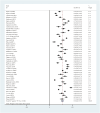Incidence and risk factors for psychological distress in adult female patients with breast cancer: a systematic review and meta-analysis
- PMID: 38544846
- PMCID: PMC10965559
- DOI: 10.3389/fpsyt.2024.1309702
Incidence and risk factors for psychological distress in adult female patients with breast cancer: a systematic review and meta-analysis
Abstract
Introduction: Cancer-related distress can be described as a complex and unpleasant combination of psychological (such as cognitive, behavioral, and emotional), social, and spiritual challenges that may impact an individual's ability to effectively cope with the physical symptoms of cancer and its treatment. Existing literature has confirmed psychological distress (PD) as an important sequela of breast cancer diagnosis and treatment. However, the incidence and risk factors for PD in adult female patients with breast cancer remain unclear; therefore, focusing on the PD of female breast cancer patients is meaningful, as they are at highest risk of contracting breast cancer, and might differ in their coping styles from men.
Objective: This review aimed to identify the incidence and risk factors for PD in adult woman patients with breast cancer, and to help guide targeted intervention to prevent distress.
Method: PubMed, Embase, Cochrane Library, CINAL, PsycINFO, China Knowledge Resource Integrated Database, Wanfang Database, the Chinese Biomedical Database, and Weipu Database were searched for data regarding the incidence and risk factors of PD in adult women with breast cancer.
Results: The prevalence of PD, assessed using the distress thermometer, ranged between 11.2%-86.7%, and a meta-analysis of 47 studies with 15,157 adult female breast cancer patients showed that the pooled prevalence was 52.0%. Further, this study identified 40 risk factors. However, owing to the inclusion of at least two studies for a certain risk factor, 10 risk factors were merged for the meta-analysis. Independent risk factors included higher education level, late-stage tumor, emotional concerns, no medical insurance, modified radical mastectomy, and history of depression; age and neuroticism were not associated with PD; and higher monthly income was revealed as a protective factor against it.
Conclusion: The incidence of PD in female patients with breast cancer is high and it involves 10 risk factors, though some are controversial owing to insufficient evidence. Further research is needed to explore the underlying mechanisms of PD and develop risk factor-based holistic intervention programs to reduce its incidence.
Systematic review registration: The protocol of this study has been registered in the database PROSPERO (registration ID: CRD42023433578).
Keywords: breast cancer; incidence; psychological distress; review; risk factor.
Copyright © 2024 Tao, Xiang, Zeng, Fu, Li and Chen.
Conflict of interest statement
The authors declare that the research was conducted in the absence of any commercial or financial relationships that could be construed as a potential conflict of interest.
Figures
Similar articles
-
Prevalence and associated factors of psychological distress among patients with breast cancer: a systematic review and meta-analysis.BMJ Open. 2024 Sep 26;14(9):e077067. doi: 10.1136/bmjopen-2023-077067. BMJ Open. 2024. PMID: 39327054 Free PMC article.
-
Behavioural modification interventions for medically unexplained symptoms in primary care: systematic reviews and economic evaluation.Health Technol Assess. 2020 Sep;24(46):1-490. doi: 10.3310/hta24460. Health Technol Assess. 2020. PMID: 32975190 Free PMC article.
-
The psychosocial experiences of women with breast cancer across the lifespan: a systematic review protocol.JBI Database System Rev Implement Rep. 2015 Jan;13(1):112-21. doi: 10.11124/jbisrir-2015-1795. JBI Database System Rev Implement Rep. 2015. PMID: 26447012
-
Telephone interventions for symptom management in adults with cancer.Cochrane Database Syst Rev. 2020 Jun 2;6(6):CD007568. doi: 10.1002/14651858.CD007568.pub2. Cochrane Database Syst Rev. 2020. PMID: 32483832 Free PMC article.
-
Beyond the black stump: rapid reviews of health research issues affecting regional, rural and remote Australia.Med J Aust. 2020 Dec;213 Suppl 11:S3-S32.e1. doi: 10.5694/mja2.50881. Med J Aust. 2020. PMID: 33314144
Cited by
-
Impact of Unmet Social Needs on Access to Breast Cancer Screening and Treatment: An Analysis of Barriers Faced by Patients in a Breast Cancer Navigation Program.Ann Surg Oncol. 2025 Sep;32(9):6652-6659. doi: 10.1245/s10434-025-17608-y. Epub 2025 Jul 2. Ann Surg Oncol. 2025. PMID: 40601094 Free PMC article.
-
Validation and application of the breast cancer distress thermometer in Chinese patients: Cutoff scores and stage-specific manifestations.Asia Pac J Oncol Nurs. 2025 Apr 26;12:100705. doi: 10.1016/j.apjon.2025.100705. eCollection 2025 Dec. Asia Pac J Oncol Nurs. 2025. PMID: 40688107 Free PMC article.
-
Psychiatric disorders in patients with benign and malignant sinonasal tumors: a prospective cross-sectional study.Front Psychol. 2024 Dec 11;15:1444522. doi: 10.3389/fpsyg.2024.1444522. eCollection 2024. Front Psychol. 2024. PMID: 39723395 Free PMC article.
-
Early Cancer Survivorship Distress Trajectories Associated With Socioeconomic Status and Age: Findings From a Multicenter Prospective Study.Cancer Med. 2025 Aug;14(15):e71076. doi: 10.1002/cam4.71076. Cancer Med. 2025. PMID: 40747744 Free PMC article.
-
Psychological distress among cancer patients in African countries: a systematic review and meta-analysis study.BMC Psychol. 2025 Feb 17;13(1):128. doi: 10.1186/s40359-025-02447-z. BMC Psychol. 2025. PMID: 39962603 Free PMC article.
References
-
- Mitchell AJ, Chan M, Bhatti H, Halton M, Grassi L, Johansen C, et al. . Prevalence of depression, anxiety, and adjustment disorder in oncological, haematological, and palliative-care settings: Aa meta-analysis of 94 interview-based studies. Lancet Oncol. (2011) 12:160–74. doi: 10.1016/S1470-2045(11)70002-X - DOI - PubMed
Publication types
LinkOut - more resources
Full Text Sources




